Aesculus glabra
Aesculus glabra, commonly known as Ohio buckeye,[2] is a species of tree in the soapberry family (Sapindaceae) native to North America.
| Ohio buckeye | |
|---|---|
 | |
| Scientific classification | |
| Kingdom: | Plantae |
| Clade: | Tracheophytes |
| Clade: | Angiosperms |
| Clade: | Eudicots |
| Clade: | Rosids |
| Order: | Sapindales |
| Family: | Sapindaceae |
| Genus: | Aesculus |
| Species: | A. glabra |
| Binomial name | |
| Aesculus glabra | |
 | |
| Generalized natural range | |
Its natural range is primarily in the Midwestern and lower Great Plains regions of the United States, extending southeast into the geological Black Belt of Alabama and Mississippi.[3] It is also found locally in the extreme southwest of Ontario, on Walpole Island in Lake St. Clair.[4]
It is found in a variety of natural habitats, including streambanks, upland mesic forests, and along the margins of old fields.[5] It is typically found in calcareous areas.[6]
Description
The leaves are palmately compound with five leaflets 8–16 cm (3–6+1⁄2 in) long and broad. The flowers are produced in panicles in spring, red, yellow to yellow-green, each flower 2–3 cm (3⁄4–1+1⁄4 in) long with the stamens longer than the petals (unlike the related yellow buckeye, where the stamens are shorter than the petals). The fruit is a round capsule 4–5 cm (1+1⁄2–2 in) diameter, containing one nut-like seed, 2–3 cm (3⁄4–1+1⁄4 in) in diameter, brown with a whitish basal scar.
The inedible seeds contain tannic acid and are poisonous to cattle and humans. The young foliage, shoots, and bark are also poisonous to some degree.[7] However, Native Americans reportedly did eat buckeye fruit after boiling it to extract tannin.[8]
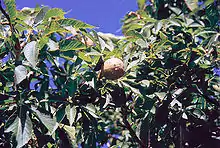 Foliage and fruit
Foliage and fruit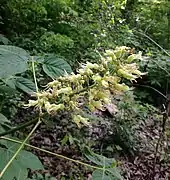 Inflorescence
Inflorescence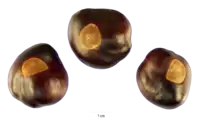 Dried buckeye nuts
Dried buckeye nuts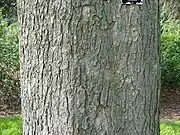 Closeup of trunk
Closeup of trunk
Uses
Aesculus glabra has little use as a timber tree due to its soft, light wood.[7] Although occasionally seen in cultivation, the large, copiously produced fruits make it generally undesirable as a street tree.[2] Extracts from A. glabra have shown anti-cancer properties.[9]
Native American ethnobotany
The Lenape carry the nuts in their pockets for rheumatism, and an infusion of ground nuts is mixed with sweet oil or mutton tallow for earaches. They also grind the nuts and use them to poison fish in streams.[10][11]
Native Americans blanched buckeye nuts, extracting the tannic acid for use in making leather. The nuts can also be dried, turning dark as they harden with exposure to the air, and strung into necklaces similar to those made from the kukui nut in Hawaii.[12]
Culture
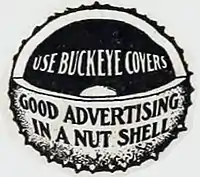
The Ohio buckeye is the state tree of Ohio, and its name is an original term of endearment for the pioneers on the Ohio frontier. Subsequently, "buckeye" came to be used as the nickname and colloquial name for people from Ohio.[13] Ohio State University adopted "Buckeyes" officially as its nickname in 1950, and also uses the name for its sports teams.[14] It came to be applied to any student or graduate of the university.[15]
Buckeye candy, made to resemble the tree's nut, is made by dipping a ball of peanut butter fudge in milk chocolate, leaving a circle of the peanut butter exposed.[16] These are a popular treat in Ohio, especially during the Christmas and college football seasons.[17][18]
Buckeyes (the nuts) are a recurring theme in Bill Watterson's comic, Calvin and Hobbes, often as one of Calvin's tools of torment.[19] Watterson himself grew up in Chagrin Falls, Ohio.[20]
References
- Stritch, L. (2018). "Aesculus glabra". IUCN Red List of Threatened Species. 2018: e.T60757589A60757592. doi:10.2305/IUCN.UK.2018-1.RLTS.T60757589A60757592.en. Retrieved 11 November 2021.
- Aesculus glabra Missouri Botanical Garden
- "Aesculus glabra". County-level distribution map from the North American Plant Atlas (NAPA). Biota of North America Program (BONAP). 2014. Retrieved 30 April 2021.
- Ohio Buckeye Official website of the Ontario Government
- Yatskievych, George (2013). Flora of Missouri, Volume 3. Missouri Botanical Garden Press. p. 1087.
- Weakley, Alan (2020). "Flora of the Southeastern United States".
- Ohio Buckeye, in Silvics Manual Volume 2: Hardwoods USDA Forest Service
- Weeks, Sally S. (2010). Native trees of the Midwest : identification, wildlife values, and landscaping use (Rev. and expanded 2nd ed.). West Lafayette, Ind.: Purdue University Press. p. 96. ISBN 978-1612490014.
- Suzawa, Rita (December 2022). Evaluation of Cytotoxic Compounds from The Buckeye Tree: Aesculus glabra (Thesis thesis). The Ohio State University.
- Tantaquidgeon, Gladys, 1972, Folk Medicine of the Delaware and Related Algonkian Indians, Harrisburg. Pennsylvania Historical Commission Anthropological Papers #3, page 30
- Tantaquidgeon, Gladys, 1942, A Study of Delaware Indian Medicine Practice and Folk Beliefs, Harrisburg. Pennsylvania Historical Commission, page 25, 74
- Horton, Marcus (30 November 2019). "Football: Ohio State-Michigan rivalry inspires longstanding devotion". The Lantern. Retrieved 19 September 2020.
- "Archived copy" (PDF). Archived from the original (PDF) on 2008-04-28. Retrieved 2008-04-28.
{{cite web}}: CS1 maint: archived copy as title (link) - Walsh, Christopher (2009). Ohio State Football Football Huddleup, Triumph Books (Random House, Inc.), ISBN 978-1-60078-186-5, p. 120.
- "The Ohio State University Alumni Association". Retrieved 19 September 2020.
- "Buckeyes". Food Network. Retrieved 19 September 2020.
- Campanelli, John (22 November 2010). "PDQ's guide to the buckeye, just in time for the OSU-Michigan game". The Plain Dealer. Retrieved 19 September 2020.
- "The 10 Best Places For Chocolate Buckeye Lovers Around Ohio". Columbus Navigator. Retrieved 19 September 2020.
- "Calvin and Hobbes by Bill Watterson for December 14, 2009". GoComics. Retrieved 19 September 2020.
- Dietz, Cortni. "Northeast Ohio Native and Calvin and Hobbes Creator Bill Watterson Has Last Hurrah". Cleveland Scene. Archived from the original on 21 October 2020. Retrieved 19 September 2020.
Further reading
- Darbyshire, S. J., & Oldham, M. J. (1985). "Ohio buckeye, Aesculus glabra, on Walpole Island, Lambton County, Ontario". Canad. Field-Nat. 99: 370–372.
- Farrar, J. R. (1995). "Ohio Buckeye". Trees in Canada. Fitzhenry & Whiteside Ltd. (Markham, Ontario) and the Canadian Forest Service (Ottawa). p. 157.
